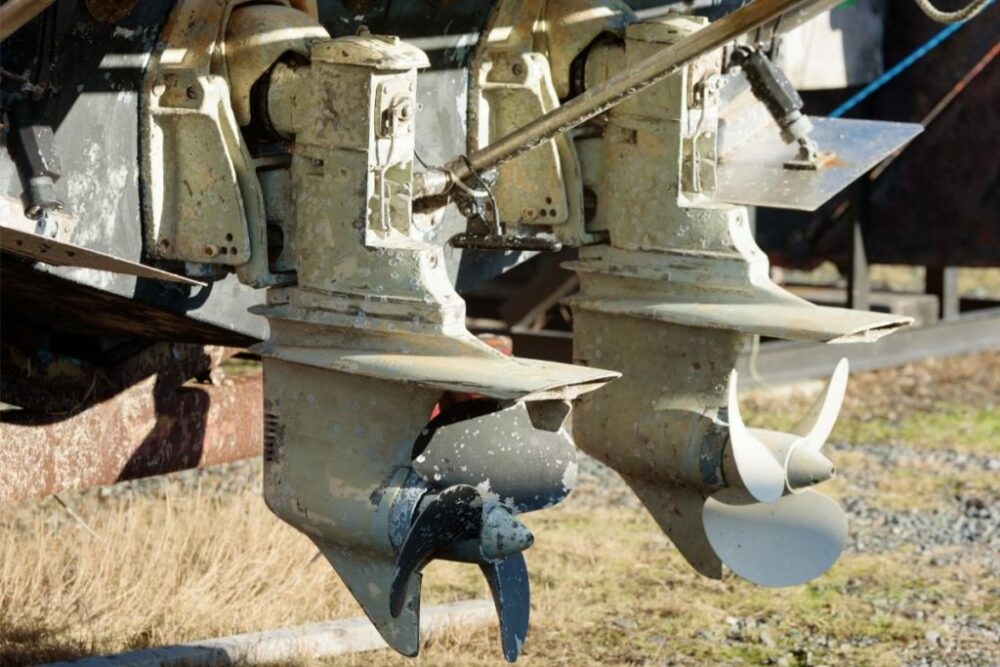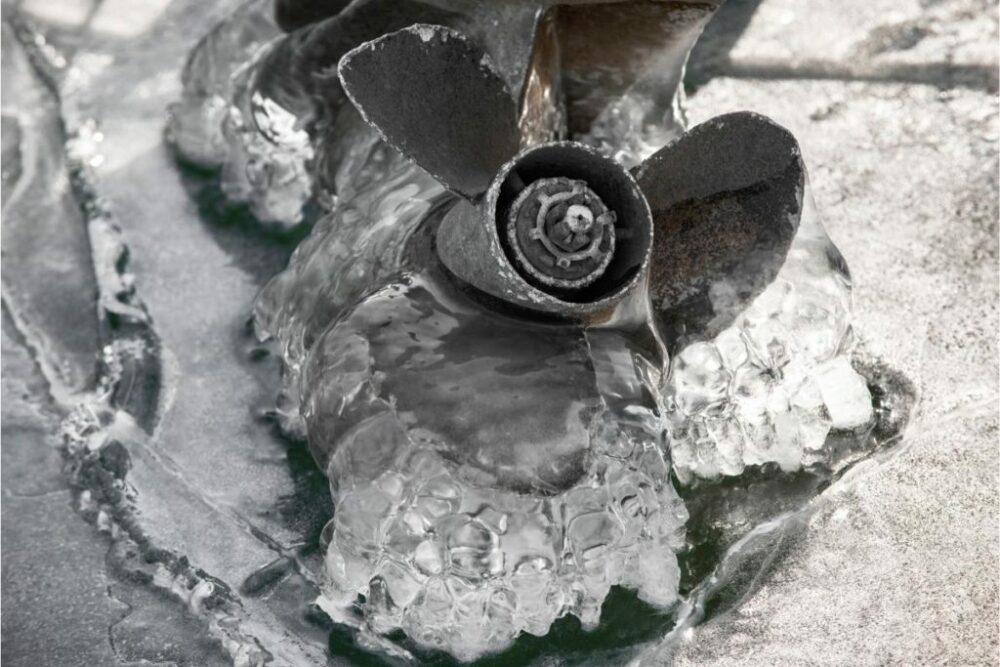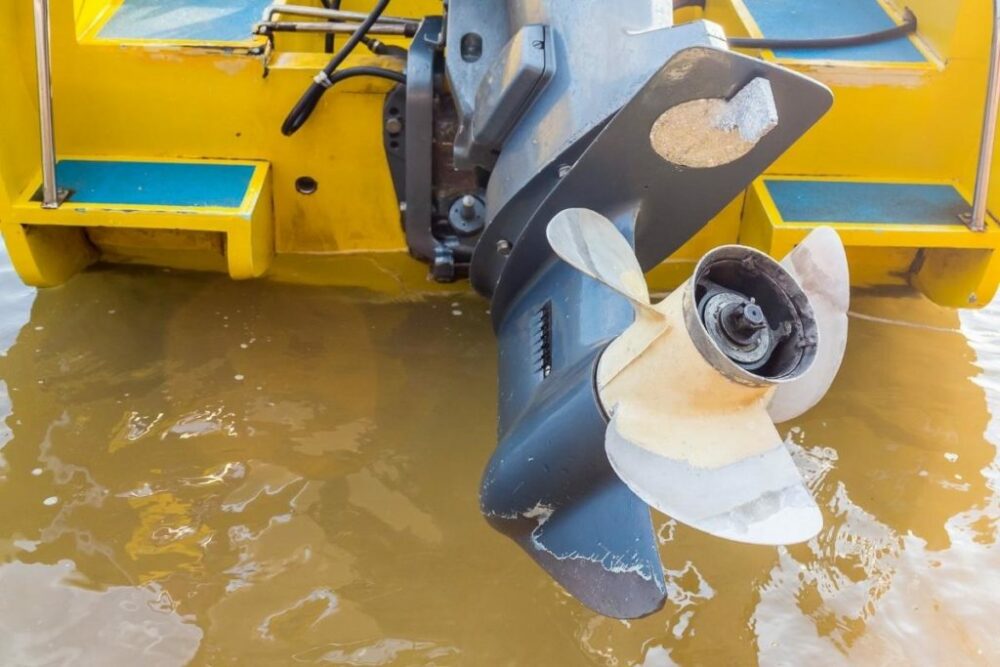Propeller cavitation is a common issue that can affect the performance of boats and ships. Cavitation occurs when the pressure around the propeller drops so low that water vaporizes, forming bubbles that collapse and cause damage to the propeller blades.
This can lead to reduced speed, increased fuel consumption, and even damage to the propeller and other components of the vessel. Understanding the causes and effects of propeller cavitation is crucial for anyone who operates or maintains a boat or ship.
Fortunately, there are several ways to reduce or eliminate cavitation issues, such as adjusting the propeller design, reducing the vessel’s speed, or improving the flow of water around the propeller. By taking steps to prevent cavitation, boat owners and operators can improve their vessel’s performance and avoid costly repairs.

This article will fully explain propeller cavitation and explore the various ways it can be reduced or eliminated. It will cover the different types of cavitation, the factors that contribute to its occurrence, and the effects it can have on a vessel’s performance.
Additionally, the article will provide practical tips and strategies for preventing cavitation issues and maintaining a boat or ship’s propeller in optimal condition.
What is Propeller Cavitation?
Propeller cavitation is a phenomenon that occurs when the pressure on one side of a propeller blade drops below the vapor pressure of water, causing water to boil and form small bubbles. These bubbles then collapse as they move to the higher pressure area, creating a shock wave that can damage the blade surface and reduce the propeller’s efficiency.
Types of Cavitation
There are two types of cavitation: face cavitation and back cavitation. Face cavitation occurs on the driving face of the propeller and is often due to an incorrect pitch distribution along the length of the blade resulting in the tip pitch being too small and the blade sections developing a negative angle of attack.
Its results are frequently found on controllable pitch units. Back cavitation, on the other hand, occurs on the suction side of the blade and is usually caused by a high angle of attack or a blade surface irregularity.
Another type of cavitation is called supercavitation. It occurs when the entire back of the propeller is covered in sheet cavitation, resulting in a loss of speed. This phenomenon is less common and occurs only when the propeller is operating at very high speeds.
Propeller cavitation is a common problem that can occur in many different types of boats. To reduce cavitation, boat owners can install a cavitation plate on their boats. This plate helps to redirect water flow and reduce the amount of turbulence around the propeller, which in turn reduces the risk of cavitation. For more information on cavitation plates, refer to the article on cavitation plates on boats.
Causes of Propeller Cavitation
Propeller cavitation is a common phenomenon that occurs when the pressure on the surface of the propeller blades drops below the vapor pressure of water, causing small vapor bubbles to form.
These bubbles then collapse under pressure, creating shock waves that can cause significant damage to the propeller blades and reduce the efficiency of the propulsion system. Several factors can contribute to propeller cavitation, including:

Hydrodynamic Factors
Hydrodynamic factors refer to the physical properties of the water and its interaction with the propeller. Some of the key hydrodynamic factors that can cause cavitation include:
- High water velocity
- Low water temperature
- High water density
- High propeller loading
- Propeller blade shape and size
Design Factors
The design of the propeller can also play a significant role in the occurrence of cavitation. Some of the key design factors that can contribute to cavitation include:
- Propeller blade pitch and diameter
- Number of blades
- Blade area ratio
- Propeller skew and rake
- Hub and blade thickness
Operational Factors
How the propeller is operated can also affect the likelihood of cavitation. Some of the key operational factors that can contribute to cavitation include:
- Speed of the vessel
- Depth of the propeller
- Thrust and torque generated by the propeller
- Water flow around the vessel
- Trim and heel of the vessel
Reducing propeller cavitation requires a combination of careful design, proper operation, and regular maintenance. By understanding the factors that contribute to cavitation, designers, and operators can take steps to minimize its occurrence and protect the propeller from damage.
For boats, one way to reduce cavitation is by installing a cavitation plate. According to an article on Cult of Sea, a cavitation plate is a flat surface that is mounted above the propeller to redirect water flow and reduce turbulence, thereby reducing the likelihood of cavitation.
Effects of Propeller Cavitation
Propeller cavitation can have several negative effects on a vessel’s performance and equipment. One of the most significant effects is the reduction in propeller efficiency, which can lead to increased fuel consumption and slower speeds. This is because cavitation causes the propeller to lose its grip on the water, resulting in less thrust being generated.
Cavitation can also cause excessive vibration and noise, which can be uncomfortable for passengers and crew. In addition, the formation of air bubbles on the propeller can cause damage to the blades over time. This damage can result in reduced performance and increased maintenance costs.
Another effect of propeller cavitation is the erosion of the propeller blades. This is caused by the implosion of the air bubbles created by cavitation, which can cause small pits to form on the blade surface. Over time, this erosion can lead to reduced efficiency and performance, as well as increased maintenance costs.
To reduce the negative effects of propeller cavitation, several measures can be taken. One option is to use a propeller with a higher number of blades, which can help to distribute the load more evenly and reduce the risk of cavitation. Another option is to adjust the pitch of the propeller blades to reduce the angle of attack and the risk of cavitation.
Additionally, the use of a cavitation plate can help to reduce the formation of air bubbles on the propeller. This plate is mounted on the transom of the vessel and redirects the flow of water to create a smoother flow over the propeller blades. For more information on cavitation plates, refer to the article on cavitation plates on boats.

Methods to Reduce Propeller Cavitation
Hydrodynamic Design Improvements
One of the most effective ways to reduce propeller cavitation is to improve the hydrodynamic design of the propeller. This can be achieved by optimizing the blade shape and pitch, as well as the diameter and number of blades.
Computational fluid dynamics (CFD) simulations can be used to analyze the flow around the propeller and identify areas of high pressure and low pressure that are likely to cause cavitation.
Based on this analysis, the propeller can be redesigned to reduce these pressure fluctuations and minimize the risk of cavitation.
Operational Changes
Another way to reduce propeller cavitation is to make operational changes to the vessel. For example, reducing the speed of the vessel can reduce the flow velocity around the propeller and minimize the risk of cavitation.
Similarly, reducing the vessel’s draft can increase the depth of the water and reduce the pressure drop around the propeller. In addition, avoiding sharp turns and sudden changes in direction can reduce the risk of cavitation by minimizing the flow disturbances around the propeller.
Material Improvements
Propeller cavitation can also be reduced by improving the material properties of the propeller. For example, using materials with higher strength and stiffness can reduce the risk of blade deformation and vibration, which are major contributors to cavitation. Similarly, using materials with high resistance to erosion and corrosion can reduce the risk of pitting and other damage caused by cavitation.
Overall, a combination of hydrodynamic design improvements, operational changes, and material improvements can be used to reduce propeller cavitation and improve the performance and efficiency of marine vessels. Additionally, installing a cavitation plate on boats can also help reduce the risk of cavitation.
Conclusion
Propeller cavitation is a common problem that can cause a lot of issues for boats and ships. Cavitation can reduce performance, cause blade erosion, create vibration, and generate noise. However, there are several ways to reduce or eliminate cavitation issues with a propeller.
One of the most important things to do to reduce or eliminate cavitation issues with a propeller is to discover the problem early. The sooner it is found, the faster it can be corrected. Additionally, the lack of thrust that comes with cavitation makes a boat less responsive.
Another way to reduce cavitation is to choose the right propeller for the boat or ship. Propellers with low-loaded profiles with very small angles of attack are ideal for slow ships with speeds below about 35 knots. Additionally, propellers with a higher number of blades can also help reduce cavitation.
Other methods to reduce cavitation include using a cavitation plate or a vented propeller. A cavitation plate can help redirect water flow and reduce the formation of cavitation bubbles. Vented propellers, on the other hand, have holes in the blades that allow air to flow through and reduce the chance of cavitation.
Overall, propeller cavitation is a problem that should not be ignored. By taking steps to reduce or eliminate cavitation, boat and ship owners can improve performance, reduce noise, and extend the life of their propellers.
For more information on reducing cavitation, readers can refer to the article on cavitation plates on boats.
- Types of Gas Carriers as per IGC Code – April 22, 2025
- Wind-Assisted Propulsion Systems (WAPS): A Game Changer for Maritime Decarbonization – February 6, 2025
- 10 Boat Salvage Yards in California – January 25, 2025




